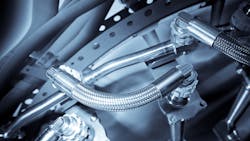In 2023, Power & Motion celebrates its 75th anniversary. Just as hydraulic and pneumatic technologies have evolved over the past 75 years, so too has the publication.
The first issue was published in February 1948 and at the time was called Applied Hydraulics. As coverage slowly expanded to provide technical information on both hydraulics and pneumatics, the publication's name was changed to Applied Hydraulics & Pneumatics in 1958. Two years later in June of 1960 the word 'Applied' was dropped from the name.
And in 2022 Hydraulics & Pneumatics rebranded as Power & Motion to be more inclusive of the increasing integration of electronics, software and other advancements taking place in the fluid power and motion control industries. With this rebranding our team is working to ensure a continued focus on hydraulic and pneumatic systems while recognizing the need to cover related technologies being integrated into or impacting fluid power systems as well.
READ MORE: Power & Motion Created to Propel Industry
Fluid Power Remains a Vital Industry
In the editor's letter of the first issue of Applied Hydraulics released in 1948, it was stated that use of hydraulic mechanisms for actuation and control had grown tremendously and showed further growth potential in the foreseeable future. The author noted much was learned about the capabilities of hydraulics as they "were designed into every plane we built" for wartime aviation programs and were now being applied to other industries.Fast forward 75 years and hydraulics have become ubiquitous in so many applications, from large construction equipment to automobiles to manufacturing equipment and more. Even with the increasing implementation of electrification, hydraulics are still considered to offer the power density required in many applications.
VISIT our archives to read past issues of Power & Motion.
However, with the move to alternative powertrain sources as well as the growth in sensor integration there are new opportunities to improve upon the efficiency of hydraulics. Precision and control can also be increased for both hydraulic and pneumatic components through the use of sensors and software, enabling new opportunities for fluid power systems.
A key phrase we continue to hear over and over is that it is an exciting time for the fluid power industry because of the many changes taking place and the role hydraulics and pneumatics will continue to play even as other power transmission technologies enter the market.
In its 2021 U.S. Fluid Power Industry Brief (the latest version available), the National Fluid Power Association (NFPA) reported the manufacture of fluid power components was an $18.2 billion industry in 2020. The association also noted that fluid power has a major downstream economic impact with several top industries depending on hydraulics and pneumatics.
And advancements within the industry will help fluid power to continue playing a vital role in many industries. Understanding the importance of evolving, the NFPA puts together its technology roadmap every 2 years to provide insight into the technological areas in which the industry and its customers can focus R&D efforts.
The NFPA is currently in the midst of developing its 2023 Technology Roadmap; most recently it has determined the customer drivers that will help shape development efforts in the coming years for hydraulics and pneumatics.
READ MORE: NFPA Sets Customer Drivers and Strategies for 2023 Technology Roadmap
To highlight the ongoing evolution of the fluid power industry as well as our own publication, throughout the year we'll revisit some of the articles and topics from the past 75 years and assess just how much has advanced, and will continue to advance in the next 75 years.
We want to hear from you!
What technologies or trends from the past 75 years would you like us to cover? How have you seen fluid power evolve during your own time in the industry? What further advancements do you see in the coming years?
Let us know! Email me at [email protected] or reach out to us on social media.
Twitter: @TechnlgyEditor or @PowerMotionTech
LinkedIn: @PowerMotionTech
About the Author
Sara Jensen
Executive Editor, Power & Motion
Sara Jensen is executive editor of Power & Motion, directing expanded coverage into the modern fluid power space, as well as mechatronic and smart technologies. She has over 15 years of publishing experience. Prior to Power & Motion she spent 11 years with a trade publication for engineers of heavy-duty equipment, the last 3 of which were as the editor and brand lead. Over the course of her time in the B2B industry, Sara has gained an extensive knowledge of various heavy-duty equipment industries — including construction, agriculture, mining and on-road trucks —along with the systems and market trends which impact them such as fluid power and electronic motion control technologies.
You can follow Sara and Power & Motion via the following social media handles:
X (formerly Twitter): @TechnlgyEditor and @PowerMotionTech
LinkedIn: @SaraJensen and @Power&Motion
Facebook: @PowerMotionTech

Leaders relevant to this article:


